The order of exercise during concurrent training for rehabilitation does not alter acute genetic expression, mitochondrial enzyme activity or improvements in muscle function
- PMID: 25289940
- PMCID: PMC4188604
- DOI: 10.1371/journal.pone.0109189
The order of exercise during concurrent training for rehabilitation does not alter acute genetic expression, mitochondrial enzyme activity or improvements in muscle function
Abstract
Concurrent exercise combines different modes of exercise (e.g., aerobic and resistance) into one training protocol, providing stimuli meant to increase muscle strength, aerobic capacity and mass. As disuse is associated with decrements in strength, aerobic capacity and muscle size concurrent training is an attractive modality for rehabilitation. However, interference between the signaling pathways may result in preferential improvements for one of the exercise modes. We recruited 18 young adults (10 ♂, 8 ♀) to determine if order of exercise mode during concurrent training would differentially affect gene expression, protein content and measures of strength and aerobic capacity after 2 weeks of knee-brace induced disuse. Concurrent exercise sessions were performed 3x/week for 6 weeks at gradually increasing intensities either with endurance exercise preceding (END>RES) or following (RES>END) resistance exercise. Biopsies were collected from the vastus lateralis before, 3 h after the first exercise bout and 48 h after the end of training. Concurrent exercise altered the expression of genes involved in mitochondrial biogenesis (PGC-1α, PRC, PPARγ), hypertrophy (PGC-1α4, REDD2, Rheb) and atrophy (MuRF-1, Runx1), increased electron transport chain complex protein content, citrate synthase and mitochondrial cytochrome c oxidase enzyme activity, muscle mass, maximum isometric strength and VO 2peak. However, the order in which exercise was completed (END>RES or RES>END) only affected the protein content of mitochondrial complex II subunit. In conclusion, concurrent exercise training is an effective modality for the rehabilitation of the loss of skeletal muscle mass, maximum strength, and peak aerobic capacity resulting from disuse, regardless of the order in which the modes of exercise are performed.
Conflict of interest statement
Figures
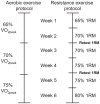

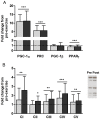

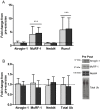
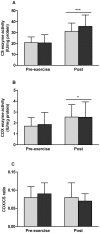
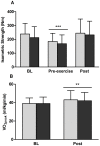
Similar articles
-
Truncated splice variant PGC-1α4 is not associated with exercise-induced human muscle hypertrophy.Acta Physiol (Oxf). 2014 Oct;212(2):142-51. doi: 10.1111/apha.12310. Epub 2014 May 21. Acta Physiol (Oxf). 2014. PMID: 24800995
-
Vitamin C and E supplementation prevents some of the cellular adaptations to endurance-training in humans.Free Radic Biol Med. 2015 Dec;89:852-62. doi: 10.1016/j.freeradbiomed.2015.10.412. Epub 2015 Oct 19. Free Radic Biol Med. 2015. PMID: 26482865 Clinical Trial.
-
Reductions in skeletal muscle mitochondrial mass are not restored following exercise training in patients with chronic kidney disease.FASEB J. 2020 Jan;34(1):1755-1767. doi: 10.1096/fj.201901936RR. Epub 2019 Dec 6. FASEB J. 2020. PMID: 31914685
-
The Effects of Dietary Protein Supplementation on Acute Changes in Muscle Protein Synthesis and Longer-Term Changes in Muscle Mass, Strength, and Aerobic Capacity in Response to Concurrent Resistance and Endurance Exercise in Healthy Adults: A Systematic Review.Sports Med. 2022 Jun;52(6):1295-1328. doi: 10.1007/s40279-021-01620-9. Epub 2022 Feb 3. Sports Med. 2022. PMID: 35113389
-
Unravelling the mechanisms regulating muscle mitochondrial biogenesis.Biochem J. 2016 Aug 1;473(15):2295-314. doi: 10.1042/BCJ20160009. Biochem J. 2016. PMID: 27470593 Review.
Cited by
-
Exercise rescues mitochondrial coupling in aged skeletal muscle: a comparison of different modalities in preventing sarcopenia.J Transl Med. 2021 Feb 16;19(1):71. doi: 10.1186/s12967-021-02737-1. J Transl Med. 2021. PMID: 33593349 Free PMC article. Review.
-
The impact of postexercise essential amino acid ingestion on the ubiquitin proteasome and autophagosomal-lysosomal systems in skeletal muscle of older men.J Appl Physiol (1985). 2017 Mar 1;122(3):620-630. doi: 10.1152/japplphysiol.00632.2016. Epub 2016 Sep 1. J Appl Physiol (1985). 2017. PMID: 27586837 Free PMC article. Clinical Trial.
-
The pleiotropic effect of physical exercise on mitochondrial dynamics in aging skeletal muscle.Oxid Med Cell Longev. 2015;2015:917085. doi: 10.1155/2015/917085. Epub 2015 Apr 5. Oxid Med Cell Longev. 2015. PMID: 25945152 Free PMC article. Review.
-
Low Cytochrome Oxidase 1 Links Mitochondrial Dysfunction to Atherosclerosis in Mice and Pigs.PLoS One. 2017 Jan 25;12(1):e0170307. doi: 10.1371/journal.pone.0170307. eCollection 2017. PLoS One. 2017. PMID: 28122051 Free PMC article.
-
Emerging role for regulated in development and DNA damage 1 (REDD1) in the regulation of skeletal muscle metabolism.Am J Physiol Endocrinol Metab. 2016 Jul 1;311(1):E157-74. doi: 10.1152/ajpendo.00059.2016. Epub 2016 May 17. Am J Physiol Endocrinol Metab. 2016. PMID: 27189933 Free PMC article. Review.
References
-
- Kraemer WJ, Patton JF, Gordon SE, Harman EA, Deschenes MR, et al. (1995) Compatibility of high-intensity strength and endurance training on hormonal and skeletal muscle adaptations. J Appl Physiol (1985) 78: 976–989. - PubMed
Publication types
MeSH terms
Grants and funding
LinkOut - more resources
Full Text Sources
Other Literature Sources
Medical
Research Materials

